Combat aircraft. Heinkel's charming provocation
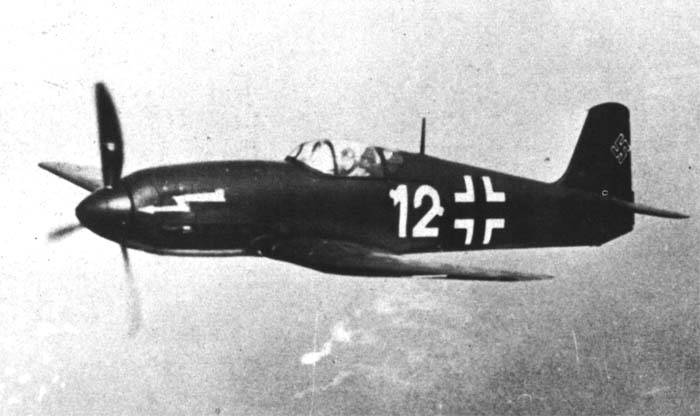
Indeed, it would seem that seaplanes are "in the subject", a bomber too, why so much spray? It is clear that there is never a lot of money and awards. And the He.111 was attacked by the Ju.88, and in the world of flying boats there were also enough competitors, the Dornier alone was worth something.
And the Ministry aviation brought to everyone that the Luftwaffe decided to optimize the issue of aircraft production in a modern way, so. that Junkers and Heinkel would deal with bombers, and Messerschmitt and Focke-Wulf fighters.
But no, there is no limit to human persistence. And even having burned himself on the He.112, Heinkel did not lose the desire to make the next Luftwaffe fighter his plane. Moreover, Heinkel's desire coincided with the desires of the company's chief designer Heinrich Hertel and Ernst Udet himself.
And in 1937, when the Ministry of Aviation was just beginning to talk about a possible replacement of the Bf.109, the Heinkel designer Siegfried Gunter was already working on the new aircraft.
The basis was taken by the He.119 design of the Gunther brothers, an aircraft in every sense of the advanced and unusual.
Plus, the experience of working on He 112 was useful, in the new project they decided to simplify the design as much as possible in order to reduce production costs. A lot of attention (as usual with Heinkel) was paid to aerodynamics. The Project 1035 aircraft promised to be a masterpiece in this regard.
In pursuit of a decrease in aerodynamic resistance, the designers came up with the idea of installing an evaporative cooling system and even more, they wanted to abandon the oil cooler, using methanol alcohol to cool the oil, which was cooled in a surface radiator in the keel.
A feature of the project was the absence of a motor mount. The hood was reinforced and carried a motor. We can say that the carrier was the body, not the frame.
Another unusual feature of the project was the design of two different wings. The first with a span of 9,4 m and an area of 14,5 sq. m, and the second with a span of 7,6 m and an area of 11 sq. m. the fact is that Heinkel still dreamed of a speed record and therefore needed a wing of a smaller area, completely unsuitable for a fighter, but quite necessary for a record aircraft.
Project 1035 was completed on May 25, 1937, but Ernst Udet was not informed of it until October, when the assembly of the first aircraft had already been completed. In the Luftwaffe, many doubted the need to prepare a replacement for the Bf.109, but nevertheless, the Heinkel company received a contract for three experimental and 10 pre-production aircraft, which, at Heinkel's request, were named He.100.
On January 22, 1938, the first He.100 was flown into the air by the famous test pilot Hans Dieterle. But at the same time, problems began. The DV-601 engine could operate in a rather intense thermal mode, but the evaporative cooling system presented several surprises. Sharp temperature changes between the lower and upper surfaces of the wing led to the fact that the skin began to warp and even damage the wing structure.
The skin, of course, was made thicker, and the area of the radiator on the wing surface was increased. However, the cooling system did not perform well. However, it was decided to prepare and conduct a record flight along a 100 km closed route.
On March 6, 1938, a record flight took place. Suddenly, the test pilot of the Gerting company was replaced by Udet himself and set a record speed of 631 km / h.
And after this significant flight, "miracles on the bends" began. At the record, they decided to cheat, to convince potential buyers that the He.100 is actually He.112, the sales of which were so-so.
The idea arose to show that the He.112 (which is actually the He.100) is in service with the Luftwaffe, and even sets records. It was announced that the record was set by the He.112U from Udet. And all clear photographs of the plane were removed from the press.
For the official setting of the record "Daimler-Benz" was ordered a special engine, specially uprated DV-601A. The engine revs were raised from 2 to 480 per minute, and the alcohol boost system raised the power for a short time to 3 liters. from. The resource of this engine was insane - one flight at a distance of up to 000 km.
The first attempt to set a record on September 6, 1938 ended with the death of the plane. The Ne.100 took off, but one of the landing gear struts did not retract. Test pilot Nitschke tried to lower the landing gear, but the retracted wheel got stuck in the niche. On top of that, the throttle cable got bitten and it became impossible to remove the speed, which excluded landing on one rack. As a result, Nichke jumped out with a parachute, hitting the plumage and getting injured. The plane, of course, crashed.
There was hope for the He.100-V4, an aircraft from the new B series. It was somewhat different from its predecessors. In fact, it was a prototype of a production aircraft. Tests of this prototype showed very good speed qualities: near the ground the speed reached 557 km / h, and at an altitude of 5 m - 000 km / h. At an altitude of 637 m, the speed was even higher: 8 km / h. But these were isolated cases, since most flights ended before reaching any results due to the imperfection of the evaporative cooling system.
During the preparation, a very funny incident happened: the chief of staff of the French Air Force, General Joseph Vuellemin, flew in on an official visit, and flew in at the invitation of Goering. And Vüllemin arrived for a reason, but also with a publicity stunt: he chose the only experienced bomber Amio-340 as a delivery vehicle.
Everything that looked like a prototype was removed from the plane, and the emblems of the French Air Force and the personal emblem of the general were applied to it. In general, the French also pretended that they were serially producing these aircraft.
But the Germans easily outplayed their neighbors and rivals. Udet publicly, without batting an eye, said, as if answering Milch's question, that two lines were already stamping He.112, and the third would be launched in a week.
Naturally, Hans Dieterle showed off from all angles on the He.100 in front of the French cameras. And thus only convinced them that this plane is "the same serial one."
And the main thing, of course, is a record flight. On March 30, 1939, Hans Dieterle reached a speed of 746,6 km / h. Naturally, it was announced that the record was set on the He.112U. This was the first absolute speed record set in Germany.
But it lasted less than a month, until April 26, when the Messerschmitt Me.209 reached a speed of 755 km / h.
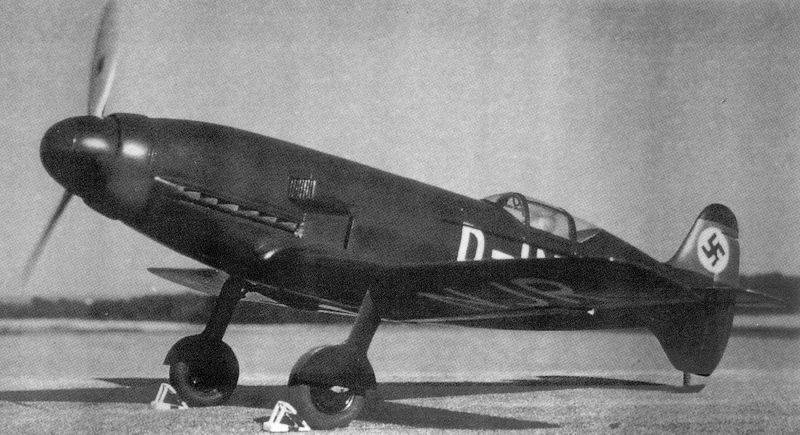
It was unexpected. Heinkel suggested that with the same engine overheating as the Messerschmitt had allowed, the Heinkel could have produced 15-20 km / h more. However, engineers began to protest against this and on July 12, the head of the engineering department Lucht ordered to curtail all work in an attempt to improve the world record.
Meanwhile, another modification of the He.100, He.100d appeared. It was a more technologically advanced aircraft. The aircraft of the d series was assembled from 969 individual units, and He.112b - from 2 885. The rivets for the aircraft went to 11 543 and 26 864, respectively. Plus, armament appeared on the d series. Theoretically, a 20 mm MG-FF cannon in the camber of the engine cylinders and two synchronous MG.17 machine guns in the root of the wing.
The keel was slightly lengthened, the lantern became vaulted and without binding. The capacity of the tanks was increased to 410 liters.
The first aircraft of this model flew in September 1939 and immediately Heinkel ordered a series of 10 aircraft to be laid down, as the Ministry of Aviation allowed him to sell aircraft for export.
Naturally, the Japanese were traditionally interested in the first new fighter. Representatives of Japanese fleet wanted to ask the price of the plane on October 30, 1939, but then it sounded like a bolt from the blue newsthat Soviet representatives were also traveling to He. Heinkel had to twist seriously so that the Japanese and Soviet specialists did not catch each other's eyes.
As a result, ours acquired three He.100d-1 aircraft and distributed them among three different research institutes for study. It was the evaporative cooling system that interested Soviet specialists, especially since we had an analogue developed by the Ilyushin Design Bureau for the TsKB-32 aircraft.
Representatives of the Japanese navy also purchased three He.100d-0 version three aircraft. And if ours paid with strategic raw materials, then the Japanese had to pay in hard currency. The planes cost them 1,2 million marks and another 1,6 million marks cost a production license.
The Japanese were very impressed with the characteristics of the He.100, they decided to immediately establish production under the name AHNe1. It was planned that this would be an air defense fighter to guard the bases of the Japanese fleet. In Cuba, a plant was built by Hitachi, where production was to begin.
However, as strange as it sounds, the Germans did not fulfill their obligations. "Heinkel" did not supply templates and accessories for the production of AHHe1 and production was not successful.
All three fighters were transported to Japan in May 1940. After assembly at Kasumigaura, they were delivered to the fleet under the designation AXHe1. The characteristics of the He.100d were so impressive that the Japanese navy immediately ordered the serial production of the aircraft as an air defense fighter of the naval bases. Production was supposed to turn on Hitachi. A new plant in Chiba was built specifically for this. But circumstances did not allow "Heinkel" to supply the necessary templates and tooling for the production of AXHe1. The work had to be stopped.
However, if you look closely, the features and components of the He.100 can be seen in the Ki-61 fighter from Kawasaki.
The Hungarians were also very interested in the plane at first. Aviation firm "Manfred Weiss" from Budapest seriously considered the licensed production of the He.100, but with the Hungarians it turned out about the same as with the Japanese, only it did not come to purchases.
That was the end of the export career of the He.100.
The most famous operation, in which the He.100 took part as an airplane, was a disinformation campaign for everyone in Europe. It happened in the 1940 Vienna. Nine He.100d-1 aircraft from the same batch under the fictitious designation He.113 played the role of different combat formations equipped with new Luftwaffe fighters.
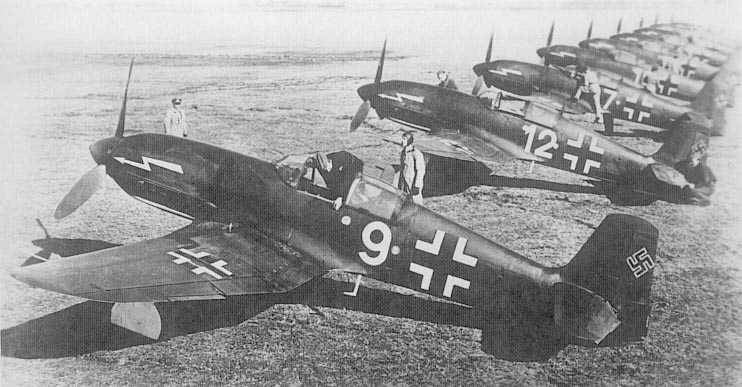
The cars were repainted, the numbers changed, badges about air victories appeared on some planes.
However, all this did not last long, intelligence agencies of different countries exposed German misinformation, the Luftwaffe received an informational blow to its pride, and interest in the He.113 disappeared as soon as it became clear that such an aircraft simply did not exist.
For there is little that can compare with the revealed secret.
However, Heinkel had another secret. Small, but it was. And it concerned weapons.
In order to uncover it, you will have to go back to the time when the commission under the leadership of TsAGI chief I.F.Petrov, which included the Deputy People's Commissar of Aviation A.V. Yakovlev, bought three He.100s.
Specifically, the Ne.100 made a very big impression on Yakovlev. No wonder, Yakovlev in our country, perhaps, was the best designer of sports aircraft. And it was Yakovlev and Stepan Suprun who first came up with the idea that the Ne.100 was more of a sports plane than a fighter. Experience, you know ...
The whole secret was that this time they paid for the planes not in gold or currency, but in raw materials. Therefore, you could “boo” and buy whatever you liked. And if the Germans suddenly balked, Petrov had the authority to spend up to a million Deutschmarks. Cash. The money would have been provided by foreign trade firms of the Soviet Union, and, moreover, immediately.
Therefore, ours bought not one, but three Heinkels. So that you can study them both thoughtfully and by all institutions interested in the new technology. Which, in fact, happened.
And in the archives of ONTI TsAGI (long live the Soviet bureaucracy, from which nothing was lost!) Reports and technical descriptions, thanks to which this secret ceased to exist.
One may ask why it has been in the archives for so many years. Obviously, our specialists were silent because the He.100 was of no value in their eyes. And one more deception, one less ...
So what are we talking about?
If you look at the reference books, and the data above were the same, then we can say with confidence that the He.100's armament consisted of a 20-mm cannon and two synchronous 7,92-mm machine guns.
But if you open the technical description of the Bureau of Scientific and Technical Information of the People's Commissariat of the Aviation Industry (BNTI NKAP) in issue No. 3 for 1941, then you can read the following information:
The Heinkel Ne.100 is armed with three MG.17 7,92 mm machine guns. Two synchronous machine guns are mounted in the wings and shoot through a plane swept by the propeller. The third machine gun is installed in the fuselage and shoots through the motor reducer shaft. Each machine gun has an ammunition capacity of 500 rounds. In terms of fire power, the aircraft's armament is of no interest.
But even earlier, in issue # 1 for 1940, there is information that the third machine gun is installed on some models, such as the He-100d-1.
And we can agree that in 1940 the value of an aircraft with three rifle-caliber machine guns was very small. The classmates were doing much better. British "Spitfire" and "Hurricane" carried eight 7,69 mm machine guns, the American P-40 had 2 x 12,7 mm + 2 x 7,62 mm, the Soviet I-16, depending on the type, carried 1 x 12,7 mm + 2 x 7,62 mm or 2 x 20 mm + 2 x 7,62 mm.
In general, you could find worse, but you would have to try.
What's the matter? Why did the MG-FF cannon suddenly disappear?
Engine. The point is the DB.601 engine, which proved to be very difficult to link with the gun. It was so difficult that on the Messerschmitt Bf 109E it was not possible to do it at all and the guns migrated to the wings.
In the He.100, it was not possible to install the cannons in the wings because of the evaporative system, which is very delicate to various shakes and vibrations.
I am sure that there were no guns on the planes that went to Japan either. It just proves the fact that even by the middle of the war, the Japanese had just begun to produce aircraft with motor-guns, and most of the fighters still carried cannon armament in their wings. But the Japanese designers collaborated very successfully with Heinkel and Junkers, there was someone to get hold of the technology.
It turns out that in general, for the sake of propaganda, the Germans were forced to lie. And lie to the fullest. And they believed ...
Indirectly confirms the absence of normal weapons and the fact that the He.100 never participated in hostilities. However, there is also something to notice here.
Well, let's say the "sportiness" of the aircraft and the low survivability of the evaporation system are not the best for a fighter. But there was also an air defense system, where a high-speed and high-altitude aircraft would be very needed. Night air defense again. Another question is how to fight?
We recall Pokryshkin and his dissatisfaction with the moment when the wing-mounted large-caliber machine guns BK were removed from his MiG. Only one 12,7 mm BS and two ShKAS remained. And the question of Alexander Ivanovich - "How to fight?"
And here, at best, three rifle-caliber machine guns ...
By the way, in 1944, as part of work on a fighter for the Reich air defense, the Heinkel company received a task to create an ultra-high-speed interceptor P1076 with exactly the same evaporative cooling system, but equipped with three 30-mm cannons. The evaporation system did not interfere with the Ministry of Aviation ... And the Japanese, relying on the experience of the Heinkel company, at the end of the war created several aircraft with a similar system.
So it's not about the sportiness of the car ...
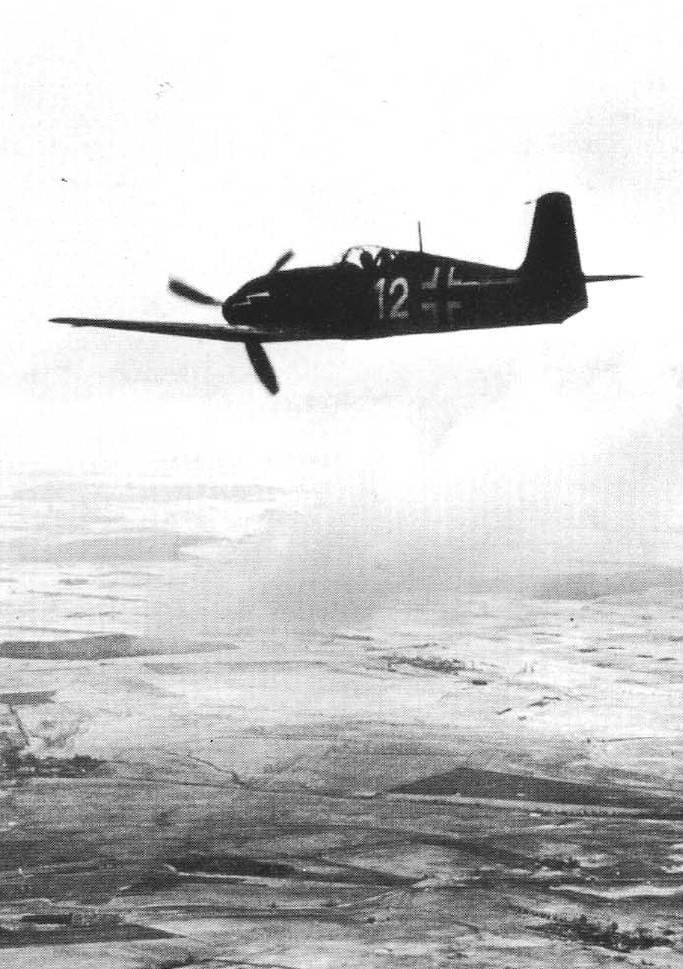
Overall, the car was interesting and breakthrough. Unusual wing profile, very close to laminar. Almost the same wing was on the Mustang, which with the same engine as the Spitfire was much faster than the latter. The absence of oil and water radiators, which disturbed the smoothness of the fuselage lines, the "licked" aerodynamic forms, the excellent quality of fit of the skin panels, hatches and hatches.
But the most interesting thing, of course, is the cooling system. More precisely, two systems, water and oil.
With water, it was like this: in the summer it was filled with water, in the winter - with a mixture of 61,5% water, 35% glycerin and 3,5% alcohol. The system worked under a pressure of 2-3 atmospheres.
The hot liquid coming out of the engine went to special separators. There part of it turned into steam, which entered the wing condensers located on the upper and lower surfaces of the wing. Steam condensed under the cold skin, and the resulting liquid was pumped into a 40-liter water tank installed in the right wing console.
There were 13 steam condensers on the plane - seven on the left wing and six on the right. Plus there was also an emergency pull-out radiator for steam condensation. It was mistaken for a retractable oil cooler, but it is not.
The area of the steam condensers was 8,3 sq. M.
There was no oil cooler in the usual sense either. More precisely, it was, but it was cooled with alcohol. That is, the oil cooler was immersed in a tank with alcohol, which evaporated and cooled the oil. Alcohol vapors entered the cooling condensers on the keel, stabilizer and fuselage behind the cockpit. There the vapors again condensed into alcohol and returned to the tank.
Everything is complicated and simple at the same time. And no additional devices for temperature control. The cooling system ensured that the proper temperature was maintained in any flight mode.
And one more thing, which, as it seems to me, played an important role in the fact that the He.100 was not adopted for service.
The plane did not have the usual engine mount. The engine was located on two beams, which were a continuation of the fuselage sides and included in the power set. The same beams served as part of the engine hood. And the whole structure was designed for the DB.601A motor, with which there were problems. This engine was required for the Bf 109 and Bf 110, and it was simply not possible to install any other engine without changing the entire nose of the fuselage.
In general, it didn’t come out very clearly. And then Tank rolled out his FW.190, which was definitely not that hemorrhoid.
The chassis mechanism was implemented in an interesting way. The regular release and retraction of the landing gear was carried out by the aircraft's hydraulic system, but the emergency release mechanism was precisely the mechanism. There was a pedal in the cockpit, by pressing on which the pilot uncoupled the locks of the retracted position of the chassis. At the same time, the racks fell out of the niches under their own weight, and the brace reached until it was fixed with a special powerful spring. Obviously, such a system was developed under the influence of the loss of a record aircraft due to a landing gear that did not come out.
As a result, I would like to draw the following conclusion: the plane was very original and promising. If I could literally do one thing: replace the engine. For example, on the high-rise DB.605, which was approximately the same size as the DB.601 and could possibly have been installed instead of the scarce 601.
And the fact that the DB.605 was perfectly “friends” with the MG.151 / 20 or even better, with the MK.108. The 30mm cannon would significantly increase the aircraft's firepower, and the machine guns could be replaced with the MG.151 in the 15mm variation.
And at the exit there would be a very high-speed and high-altitude fighter that could provide a worthy rebuff to the very Mustangs with which the Messerschmitts and Focke-Wulfs could not do anything.
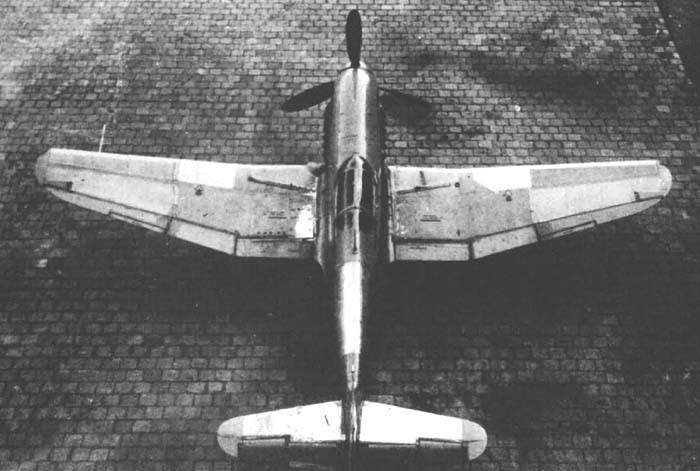
And, by the way, a few words about the scanty combat survivability of the Ne.100. Yes, based on his experience, the designer Yakovlev actually buried the He.100. But who and when checked the correctness of his words? There are no data in the same TsAGI on practical shooting at the He.100 with subsequent analysis, which means that such studies have not been carried out.
Far from all the water from the system was supplied to the steam condensers, so to say that “one or two bullet holes would disable the aircraft” is somewhat exaggerated. A couple of bullets could disable Japanese paper planes, but they fought quite normally throughout the war.
I am sure that such a "trifle" as the bullet shots of the steam condensers on the wings at Heinkel were definitely foreseen. At least they were made easily removable.
Alcohol evaporators are a delicate moment, but in any case, even without them at high altitudes one could do without.
As a result, the Luftwaffe abandoned the plane, which could be very useful: it would clear the sky from the Mustangs, taking advantage of the superiority in speed, both horizontal and vertical. And only then the links of the Messerschmitts and Focke-Wulfs would go to the “fortresses”, which would be engaged in the destruction of bombers without any particular problems.
However, these are purely theoretical calculations. In any case, Germany would hardly have been able to build He.100 in sufficient quantities. And at the turn of 1944, the Luftwaffe was crushed by a combined Allied force on both fronts.
The appearance of an interceptor could facilitate the work of the Reich's air defense. But in the command of the Luftwaffe, another very good plane was buried.
LTH He.100d-1
Wingspan, m: 9,40
Length, m: 8,20
Height, m: 3,60
Wing area, м2: 14,50
Weight, kg
- empty aircraft: 1 810
- normal takeoff: 2 500
Engine: 1 х Daimler-Benz DB.601Аа х 1175 hp
Maximum speed km / h
- near the ground: 573
- at height: 650
Cruising speed, km / h
- near the ground: 520
- at height: 635
Practical range, km: 885
Maximum rate of climb, m / min: 1087
Practical ceiling, m: 11 000
Crew, prs: 1
Armament:
- one 7,92 mm MG-17 machine gun in the collapse of the cylinders
- two 7,92 mm MG-17 machine guns at the root of the wings
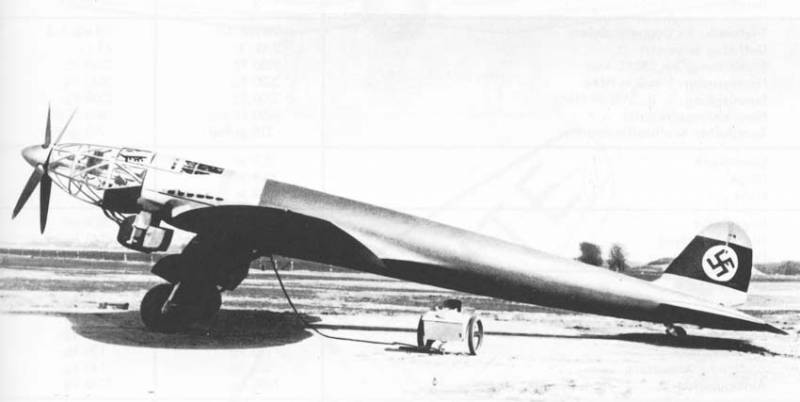
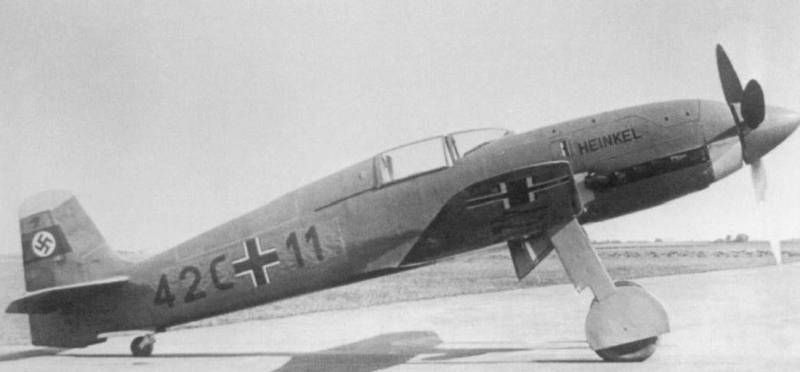
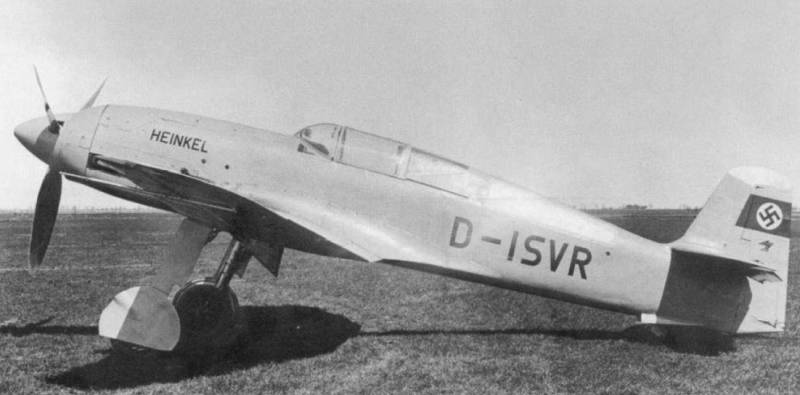
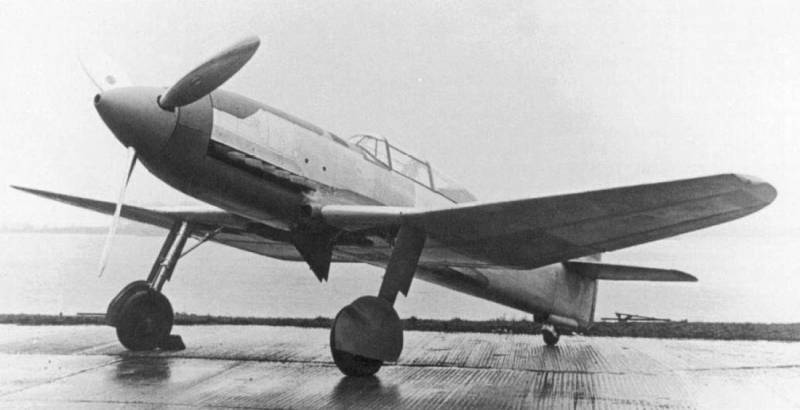
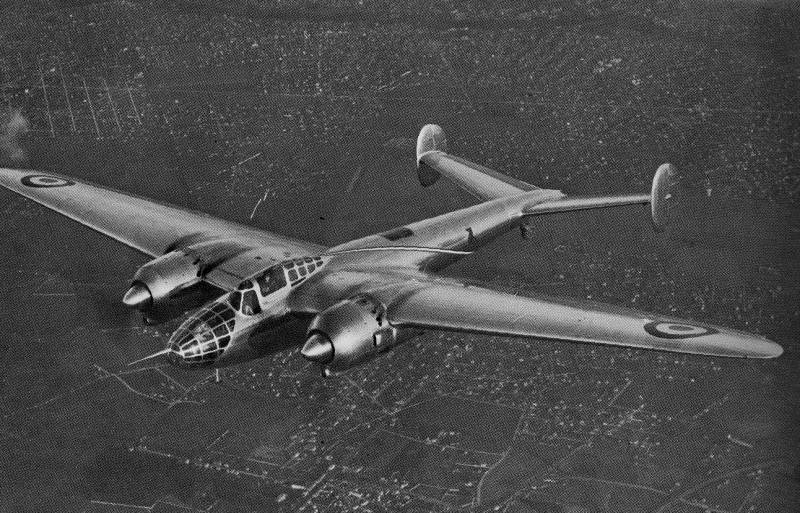
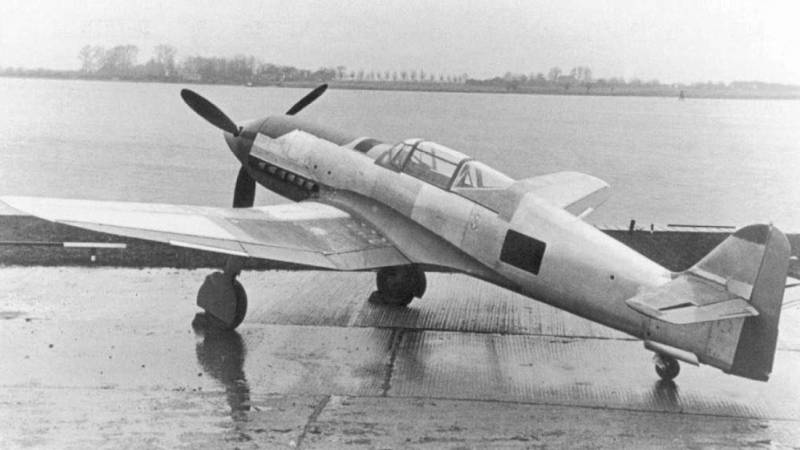
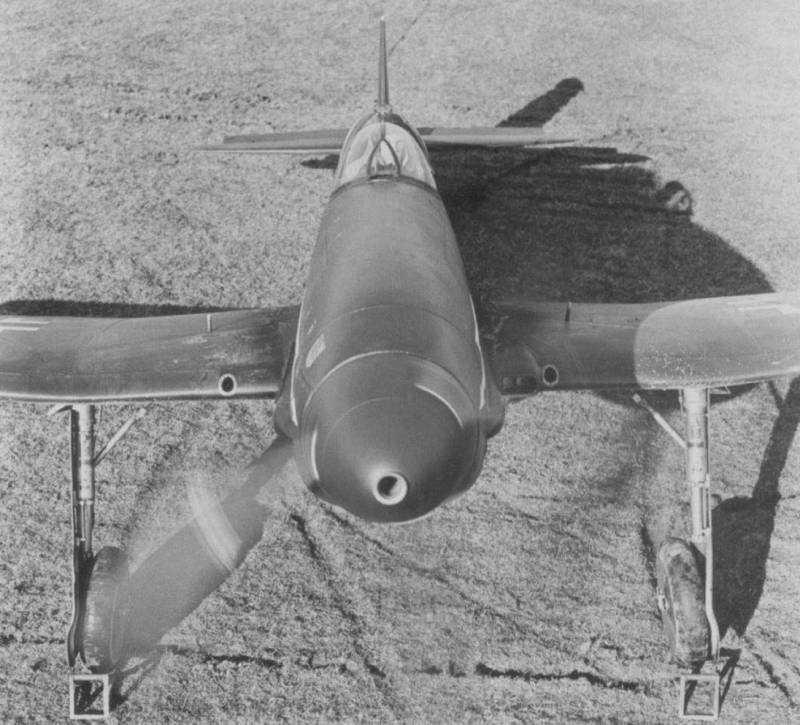
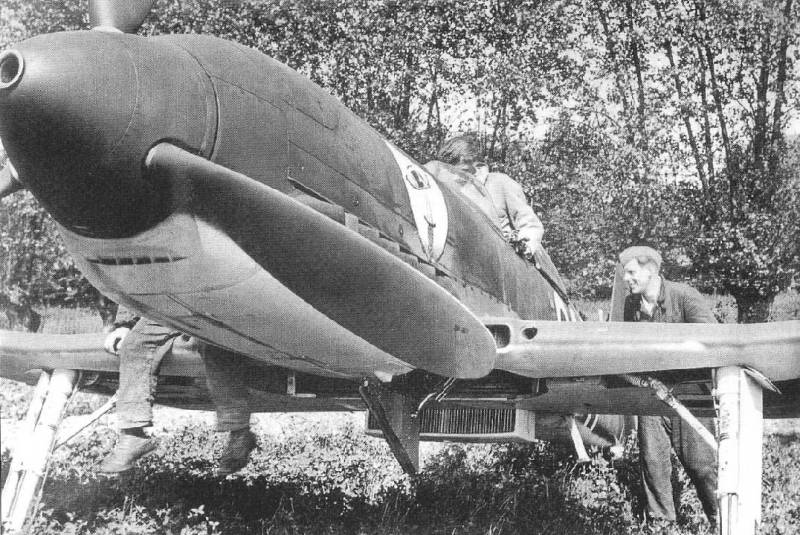
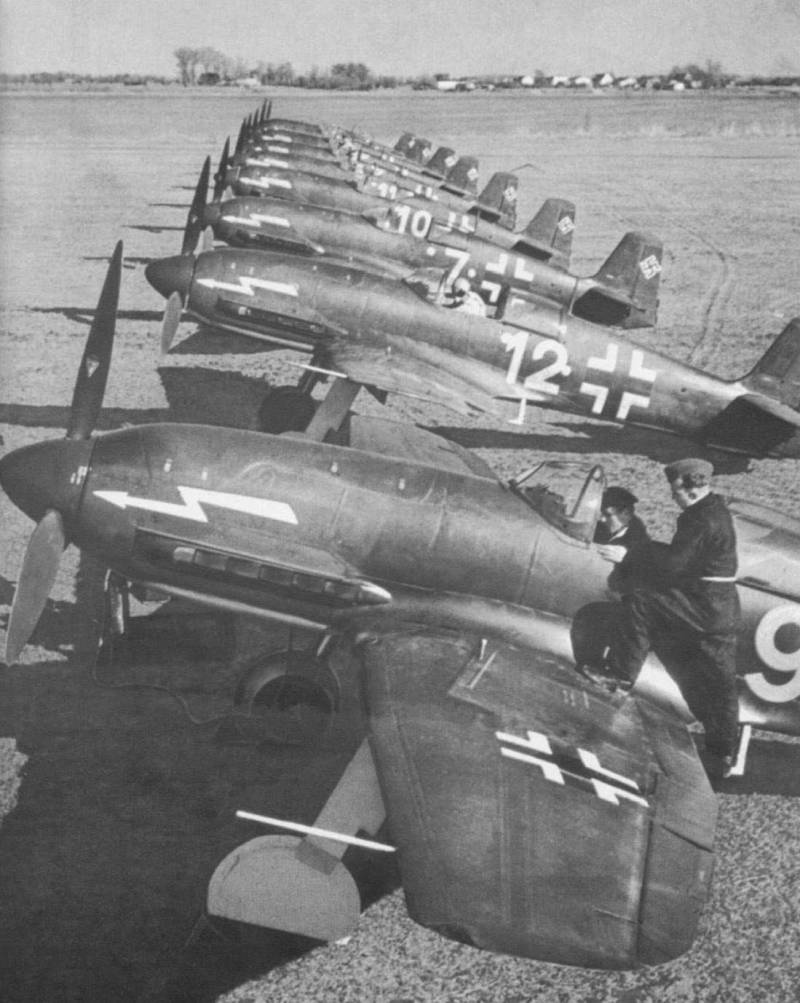
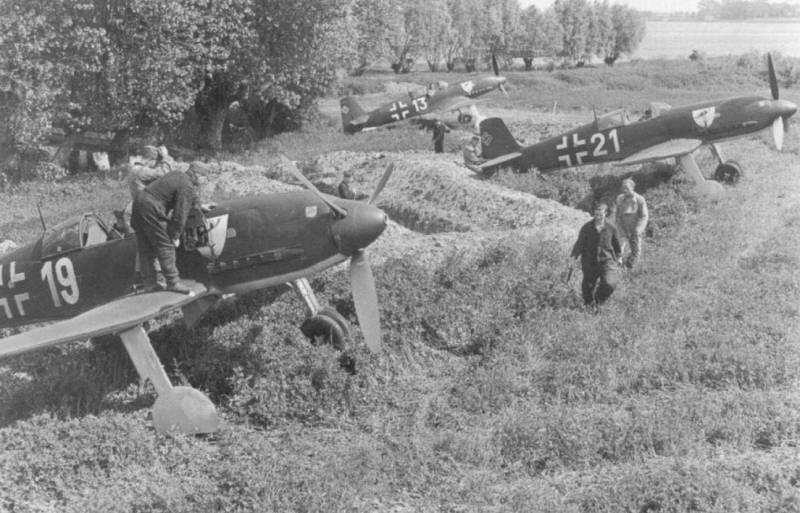
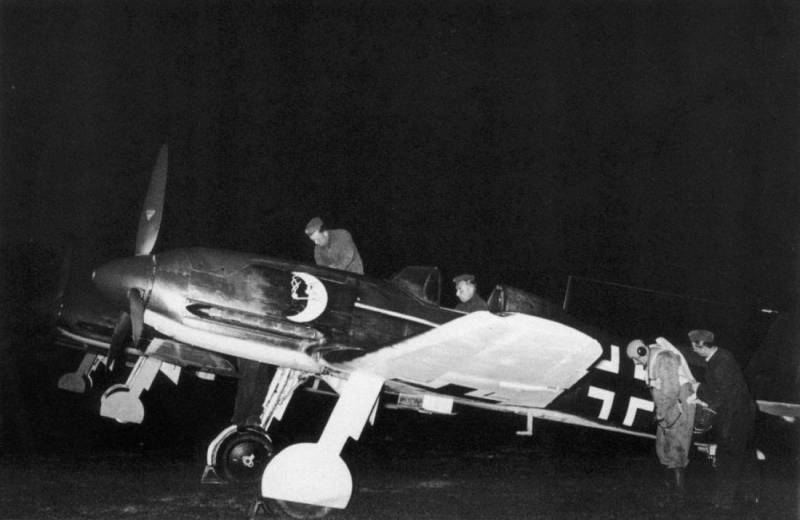
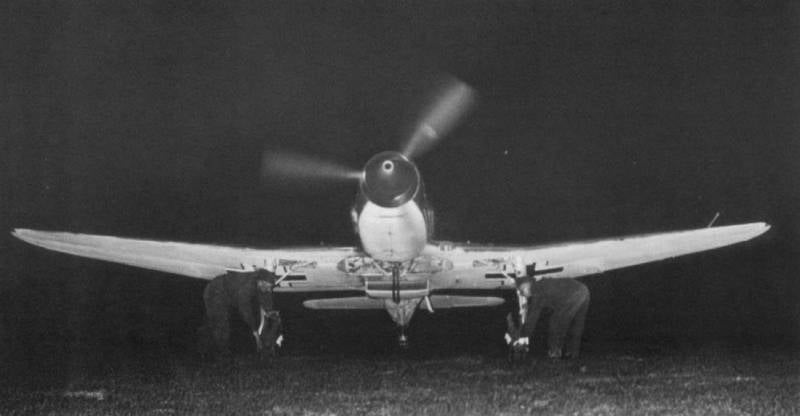
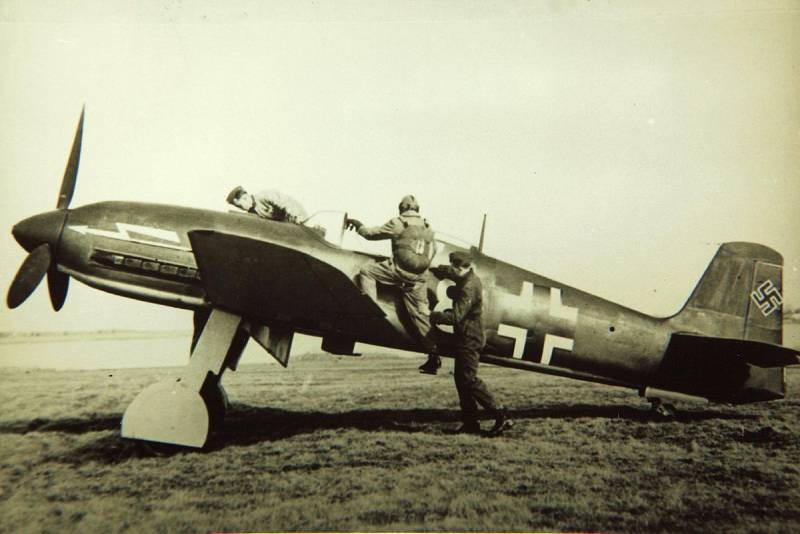
Information